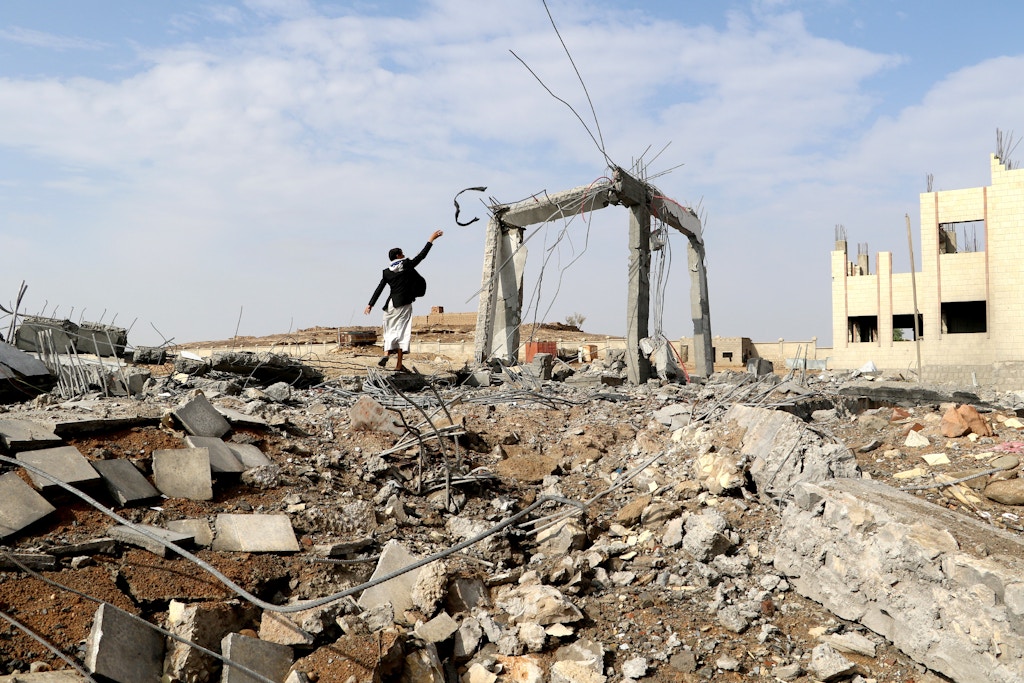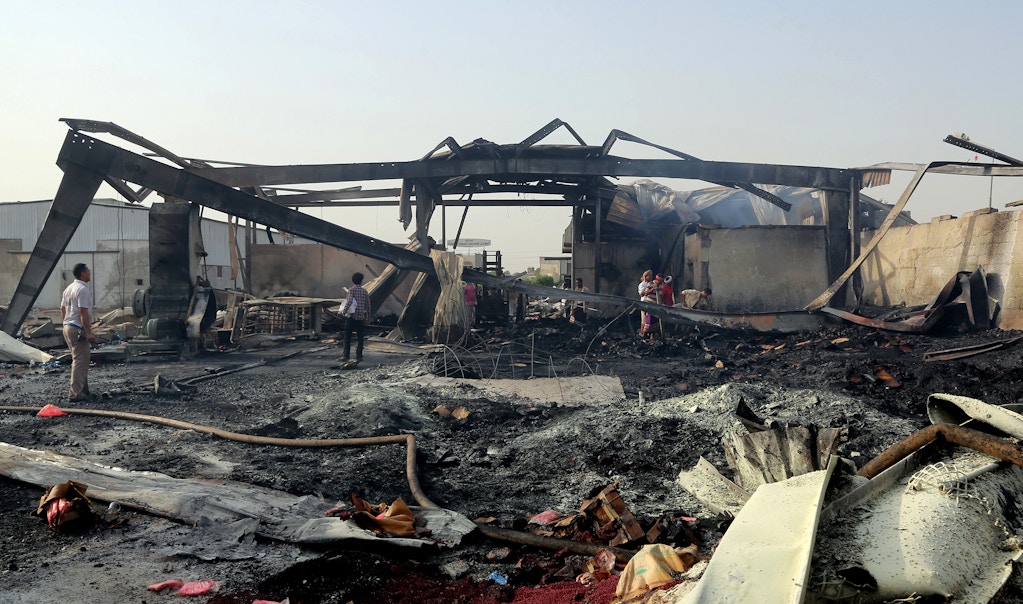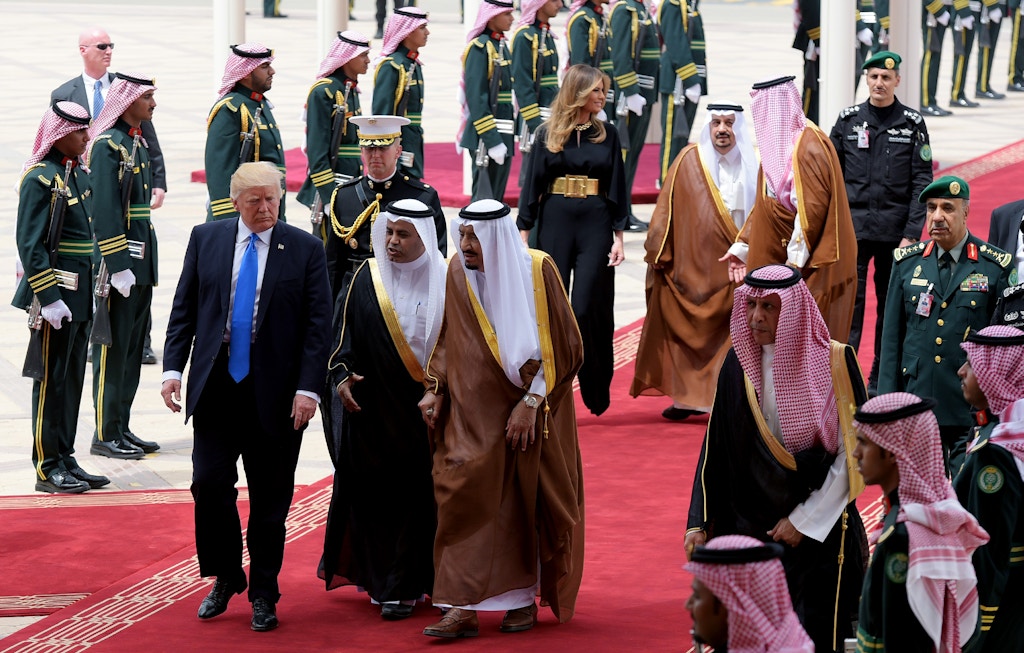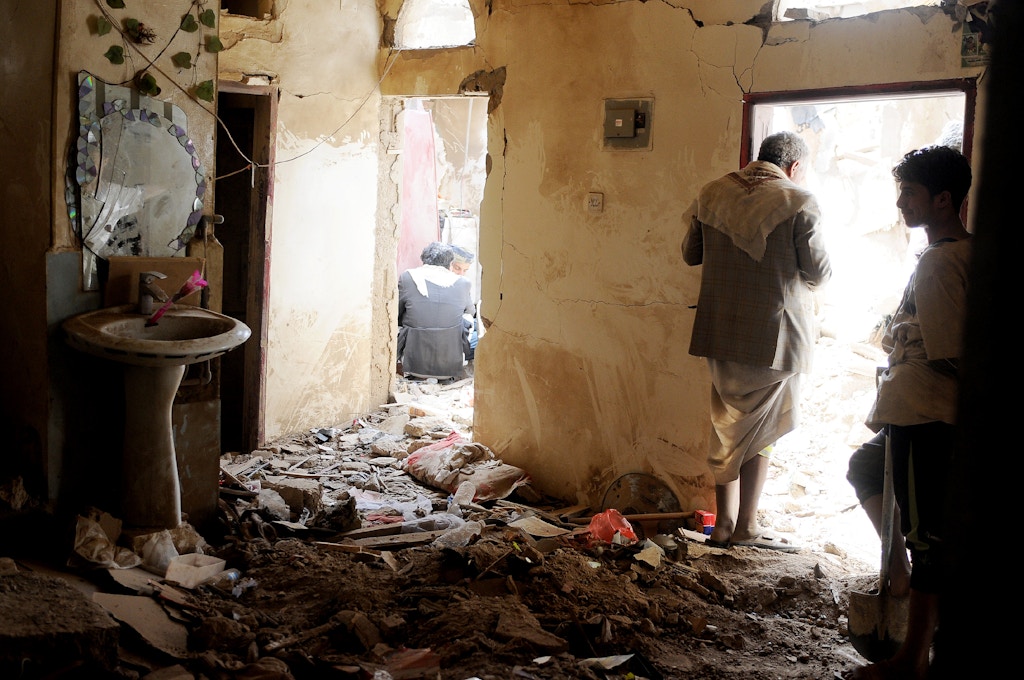by Iona Craig & Shuaib Almosawa
Shortly before 10 p.m. on the night of May 14, more than a dozen members of the Maswadah family, including nine children, lay sleeping in tents in the shadow of a cliff in Yemen’s northern governorate of Saada. The nomadic family had been eking out a living raising sheep and doing farm work in the region most heavily targeted by the U.S.-supported, Saudi-led bombing campaign that began in 2015.
Unbeknown to the Maswadahs, Royal Saudi Air Force drones had been hovering for 45 minutes over their dwellings at the edge of the wide plain walled by mountains. Saudi duty officers more than 550 miles away watched the family’s tents on their screens, along with two “hot spots” likely created by the body heat of people and animals inside.
What happened next in the Saudi war room is described in a U.S. intelligence report seen by The Intercept. The minute-by-minute account of a single airstrike provides a small yet detailed window into the Saudi-led bombing campaign in Yemen, showing how officers in charge of daily air raids are ignoring their own procedures aimed at minimizing civilian casualties. Specialists in international humanitarian law say the incident described in the document shows “clear violations” of the laws of war.
The duty officers monitoring drone feeds in the Joint Forces Command National Defense Operations Center in the Saudi capital of Riyadh on the night of May 14 saw the Maswadahs’ tents, but observed “no personnel or vehicles visible, nor any other intelligence information about the location,” according to the report.
Saudi officers monitoring drone feeds saw the Maswadahs’ tents, but had no “other intelligence information about the location” before ordering the strike.
The Saudi brigadier general in charge on May 14 wasn’t present in the operations center, so the duty officers called him twice to describe the target.
At 9:25 p.m., the absent general issued the order to strike the tents. The RSAF, which was monitoring the site separately, added its own recommendation to strike. “At 2156, an unknown coalition aircraft released a single GBU-12 on the target,” notes the document, referring to a 500-pound, American-made precision-guided bomb that was dropped at 9:56 p.m., less than 50 minutes after the Saudis first caught sight of the tents.
It is not clear whether the aircraft that fired the munition belonged to Saudi Arabia or the United Arab Emirates, which lead the coalition fighting in Yemen, or to a partner nation such as Jordan, Egypt, Bahrain, or Sudan. Morocco reportedly withdrew its fighter jets in April.
Abdullah Maswadah, 40, a farmer and father of the nine sleeping children inside the tents that night, told The Intercept that he was awake and outside the square fabric shelters trying to avoid mosquitos when the bomb dropped. Fortunately for his family, the missile failed to hit its intended target. The American-made munition missed the family’s tents, which had been donated by the Red Crescent, “by about 30 meters,” according to the intelligence report. Maswadah estimated that it landed 10 to 15 meters from where his children slept along with his wife, her parents, and her sister on sponge mattresses next to bags of clothes.
“I rushed to my tent and [the tent] had fallen on the kids. Some woke in panic, screaming and crying, and some were still asleep.”
“I rushed to my tent and [the tent] had fallen on the kids,” Maswadah said. “Some woke in panic, screaming and crying, and some were still asleep.” He moved his relatives out into the open and wiped the dust from their faces. All had survived unharmed, likely because the sides of the tents had been reinforced with stone walls.
As preparations for a second strike unfolded in the Saudi operations center, “multiple personnel, to include at least 1 female and 4 children, exited the tent and fled towards a road,” according to the document. The second strike was then aborted.
The coalition and U.S. Central Command did not respond to questions from The Intercept. But the intelligence report includes what appear to be comments from an American intelligence analyst attempting to summarize key takeaways from the misguided strike.
The attack was “an indication of failure to follow proper procedure even though safeguards are in place,” the analyst wrote, without stating what those safeguards were. “The Saudis failed to corroborate the target with additional intelligence sources or weigh the lack of time-sensitivity with the decision to strike immediately.”
Yet, in an apparent attempt to throw a positive light on the near-fatal fiasco, the analyst pointed out “the obvious desire to avoid civilian casualties and do the right thing indicated by the very real distress that was felt [by the Saudis] after they realized civilians were present.” About 15 minutes after the attack, a senior Saudi officer “expressed extreme displeasure that the strike had been ordered due to the lack of intelligence information justifying it,” the report notes. Many Saudi officers “were visibly distressed at the near-miss of a civilian casualty event. They also privately admitted failing to follow their own procedures, which were put in place to prevent incidents like this from occurring.”

A man stands at the site of an airstrike that destroyed the Community College in Saada, Yemen on April 12, 2018. Civilian locations continue to be targeted, as human rights organizations and others have repeatedly claimed since the start of the coalition air campaign.
Photo: Naif Rahma/Reuters
The Saudi officers’ failure to take any precautions to avoid civilian injury or death was a clear breach of customary international humanitarian law, as was the failure to verify the target, experts said. “Beyond viewing the tents and the hot spots, if no intelligence was ordered to determine if these were military targets, then this is definitely a violation of the principle of precaution. This is the obligation to take all necessary measures to distinguish between civilians and combatants and to minimise incidental loss of civilian life,” said Ioannis Kalpouzos, an expert on the laws of war at City Law School, University of London.
Potential U.S. complicity in violations of the laws of war is more relevant than ever.
Though the U.S. is not known to have used its own fighter pilots and attack aircraft in Yemen, it is more directly involved in the coalition’s air war than it has been in any other foreign-led bombing campaign in modern history. As the intelligence report shows, the U.S. maintains a significant presence in the Saudi operations center. It also sells munitions and aircraft to the coalition and provides maintenance, training, targeting assistance, and mid-air refueling for fighter jets carrying out bombing runs.
Potential U.S. complicity in violations of the laws of war described in the report is more relevant than ever. The U.S. reportedly increased its role in selecting targets for coalition airstrikes soon after the May 14 attack.
In mid-June, the coalition launched a major military offensive against Yemen’s port city of Hodeidah, which, along with the surrounding area, was home to 400,000 people. That assault has relied heavily on airstrikes from coalition fighter jets flown by American-trained pilots, armed with American-made missiles, and refueled in the air by U.S. planes. According to a Wall Street Journal report, the expanded U.S. role in target selection is meant to “minimize the number of civilian casualties and the harm to critical infrastructure” in the Hodeidah operation, which the United Nations humanitarian chief in Yemen has said could put 250,000 lives at risk. Some 47,230 households have so far been displaced from the governorate as a result of the fighting.

Photo: Abdo Hyder/AFP/Getty Images
In May, the Trump administration asked Congress to review the proposed sale of 120,000 precision-guided munitions to Saudi Arabia and the UAE. In June, Sen. Bob Menendez, the ranking Democrat on the Senate Foreign Relations Committee, which has the power to limit such sales, told Secretary of State Mike Pompeo and Defense Secretary Jim Mattis that he could not currently support the continued sale of U.S. PGMs – the same type used in the May 14 strike on the Maswadah family’s tents – to the coalition because of concerns over their potential use against civilians.
The intelligence report offers a devastating counterclaim to the U.S. and U.K. arguments for increasing the sale of PGMs, or “smart bombs,” to the coalition as a means of preventing civilian injury and death. Suppliers of PGMs and their political proponents claim that smart bombs, rather than unguided “dumb bombs,” are the primary way to avoid civilian harm. On its website, Raytheon – the largest manufacturer of PGMs in the U.S. – boasts that its PGMs are “avoiding casualties. Reducing risk. Minimizing collateral damage. … [O]ur precision weapons are meeting the mission — hitting the target and nothing else.” That didn’t happen in the May 14 strike, which may have missed the Maswadahs’ tents because of “elevated terrain between the weapon and the target,” according to the U.S. intelligence report.
Moreover, the efficacy of PGMs or any other weapon depends largely on the quality of the targeting. Although the U.S. has killed plenty of civilians in bombing raids across the Middle East and South Asia in recent years, the events that unfolded in the Saudi operations center on the night of May 14 differed from U.S. airstrike protocol in at least one key way: the apparent absence of legal advisers in the Saudi decision-making process.
In a U.S. campaign, lawyers from the Air Force Judge Advocate General’s Corps would usually, though not always, be expected to be involved in deciding whether to order a strike, according to a former U.S. Air Force officer who asked not to be identified because of his ongoing work in the region. Several military lawyers are available 24 hours a day for such consultation, the former officer said. It remains unclear what, if any, legal advice commanders in the Saudi-led coalition seek before carrying out airstrikes.
Concerns about civilian casualties in Yemen prompted the U.S. to suspend the sale to Saudi Arabia of kits to convert “dumb bombs” into “smart bombs,” but the Trump administration quickly reversed that policy.
In December 2016, at the end of the Obama administration, concerns about civilian casualties in Yemen prompted the U.S. to suspend the sale to Saudi Arabia of guided munitions kits to convert “dumb bombs” into “smart bombs” or PGMs, though crucial mid-air refueling of coalition fighter jets continued.
But the Trump administration quickly reversed that policy. In June 2017, the U.S. approved an estimated $750 million in flight and technical training to the Royal Saudi Air Force. In announcing the proposal, the Defense Department said that the training would “include such subjects as civilian casualty avoidance, the law of armed conflict, human rights command and control, and targeting.” A week later, U.S. senators voted to resume PGM sales to Saudi Arabia, approving the sale of more than $500 million in precision-guided munitions.
The sale closely followed President Donald Trump’s visit to the kingdom, his first official foreign visit as president. While there, he boasted of a deal with the Saudis that he claimed would be worth up to $350 billion over the next 10 years, including $110 billion in arms sales. The Obama administration concluded $115 billion worth of defense sales with Saudi Arabia from 2009 to 2016.
The intelligence report shows, however, that 11 months on and over three years into the coalition’s aerial bombing campaign in Yemen, civilians are still being unlawfully targeted, as human rights organizations, a U.N. panel of experts, humanitarian aid agencies, and the European Parliament have repeatedly claimed since the start of the coalition air campaign.

Photo: Mandel Ngan/AFP/Getty Images
Those calling for the suspension of PGM sales to the coalition argue that selling weapons that will be used to target civilians means that the U.S. “is green-lighting the killing of innocent civilians,” as well as exacerbating the humanitarian crisis in a country where more than 8 million people are “a step away from famine.”
“The U.S. and U.K. have justified continued weapons sales to Saudi Arabia based on the coalition’s purported ‘improvements’ — that they will tighten their rules of engagement or credibly investigate strikes that have already occurred,” said Human Rights Watch Yemen researcher Kristine Beckerle. “These promises are empty, these assurances fatally flawed. Whatever changes the coalition has made to its targeting practices, if any, have not prevented the coalition from bombing a wedding, a cholera treatment center, and a range of other civilian targets just this year.”
Saudi Arabia has denied numerous reports of mass civilian casualties caused by coalition airstrikes and alleged violations of the laws of war, including the bombing of hospitals, civilian gatherings, and civilian infrastructure, often with U.S.-made munitions. The coalition says it has carried out its own internal investigations into some 70 airstrikes. In nine cases, the coalition’s Joint Incident Assessment Team acknowledged fault but blamed guidance systems, pilot error, or erroneous intelligence. This week, the JIAT announced the findings of five additional investigations, stating that no violations occurred.

People search for survivors under rubble of a house after it was destroyed on June 25, 2018, by a Saudi-led coalition airstrike that killed eight members of one family and injured 15 others in Amran province north of Sana’a, Yemen.
Photo: Mohammed Hamoud/Getty Images
A February 2017 judicial review case brought by the London-based organization Campaign Against the Arms Trade argued that weapons sales to Saudi Arabia should be suspended because the Arms Trade Treaty, ratified by the U.K. in 2014, states that if there is “a risk of any serious violation of international humanitarian law,” arms exports should not be authorized. The U.K.’s High Court ruled against the group last summer, finding that there was no “real risk” of “serious violations” in such sales, and that the U.K. secretary of state’s decision to continue selling weapons to Saudi Arabia “was not irrational or unlawful.” An appeal on the ruling is expected to be heard later this year.
Although it’s unusual for new evidence to arise in such proceedings, Paul Clark, an international law expert and barrister at Garden Court Chambers in London who is not involved in the CAAT case, said The Intercept’s reporting “might count as new evidence” that could justify a new application to the High Court or submission as part of the appeal.
“If evidence of this type had been available at the time of the High Court decision, it should have impacted on the question of whether the secretary of state made a rational decision,” Clark said. CAAT declined to comment, saying that it had been advised not to speak about the pending appeal.
The U.K. Ministry of Defense’s own “Tracker” database, which collates but does not investigate alleged violations of international humanitarian law by the coalition in Yemen, listed 356 potential breaches as of July 4. Of those, 42 occurred between December 2017 and March 2018.
International law requires states to investigate war crimes by their militaries and “fairly prosecute” those responsible, notes Human Rights Watch’s Beckerle. Yet on July 10, Saudi Arabia’s King Salman issued an unprecedented “noble royal order pardoning all military men … of their respective military and disciplinary penalties” in the war in Yemen.
“The Saudi King’s recent sweeping pardon for soldiers involved in Yemen fundamentally and outrageously undercuts the already deeply flawed coalition investigative mechanism,” Beckerle told The Intercept. “The pardon is almost certain to embolden coalition officers still fighting in Yemen, given the clear message it sends: Don’t worry — no consequences.”
“The pardon is almost certain to embolden coalition officers still fighting in Yemen, given the clear message it sends: Don’t worry — no consequences.”
According to the London-based nonprofit charity Action on Armed Violence, 72 percent of civilian deaths and injuries in Yemen from 2015 to 2017 were caused by air-launched weapons. In May, coalition airstrikes were responsible for 73 percent of civilian casualties in Yemen, with 26 percent caused by shelling from Houthi rebels – the coalition’s enemy, according to AOAV, which advocates to reduce global armed violence.
The events of May 14 continue to haunt the Maswadah family. The children and other relatives have moved into caves, which they view as safer than tents. “I can feel death now when I hear the sound of fighter jets,” said Abdullah Maswadah, who, because of the move, is now a half day’s travel from his work as a farm laborer. “The kids burst into tears when they hear the sound [of planes].”
River to Sea
 Uprooted Palestinian
Uprooted Palestinian
The views expressed in this article are the sole responsibility of the author and do not necessarily reflect those of the Blog!
No comments:
Post a Comment